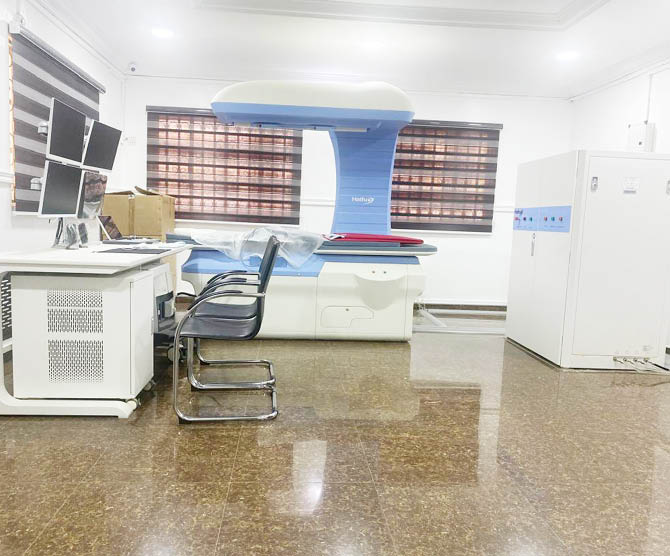Fibroid is a common disease among women in Nigeria and other black women. Experts estimate that over 70 per cent of women below 50 years are at risk of fibroid.
The disease usually manifests with bleeding abdominal mass, infertility, pelvic pain and recurrent miscarriage among others.
Surgery is a common treatment for the disease. However, it poses a challenge for many women in the country as they are often afraid of surgery as a result of the complications associated with it.
Thus some women have died because they did not seek treatment or resorted to other unhealthy or unsafe treatment methods while some died during surgery.
Medical experts say surgery is not the only option for treatment. They said High Intensity Focused Ultrasound (HIFU) is a very non-invasive method that women could consider, and that aside surgery, HIFU offered opportunity for treatment of fibroid with minimal risks, adding that it was important for Nigerians to know more about the treatment option and harness it.
HIFU is a form of treatment that converts waves of ultrasound energy to heat to burn off fibroids.
A renowned fertility expert and Chief Executive Officer of the Fibroid Care Centre, Lagos and Abuja, Dr Abayomi Ajayi, said utilising HIFU for fibroid treatment had a lot of benefits.
He said it was a treatment option that saved patients from complications associated with surgery and other methods.
Dr Ajayi further said that the selling point of the technology was that people could walk in and walk out for treatment, did not lose blood at all, and that it also treats adenomyosis (bleeding into the muscle of the uterus).
He explained that HIFU treatment did not use iodising radiation but real-time ultrasound waves to generate localised heat to specifically target fibroid and destroy it.
He said, “Now, one of the beauties of HIFU is that it is a targeted treatment. It converts ultrasonic sound energy to heat energy and concentrates it at that focal point. So, it is the only focal point where the heat is effective. It just hits the fibroid and the endometrium surrounding it is not affected. Unlike traditional methods, HIFU targets and destroys fibroid tissue without removing it, reducing the risk of complications.”
While noting that unlike surgery, where the doctor has to cut through muscles, HIFU was easy to use and safe, adding that the technology killed fibroid by coagulating the necrosis.
He said, “Coagulation means heat, then necrosis means death. So, the heat causes the death of the cells; that is the way we treat fibroid with HIFU. It focuses the ultrasound at a particular distance and that focus becomes heated up until the temperature is over 60°C, and it just denatures the protein and kills it slice by slice until it kills the whole fibroid.”
For those who wish to have children after HIFU treatment, he said, “After three months, if we check and see that everything is okay, you can proceed to have a baby. It does not affect your womb. So, it is very well-suited for people who want to have children.”
He explained that the belief by some people that HIFU was for small fibroids and not big fibroids was not true, saying, “They can be used for big fibroids. Size is not a contradiction, but the location.”
However, he noted that there was the need to pick patients that can benefit from HIFU, because just like other methods of treatment such as surgery, it was not everyone that could benefit from the technology.
He added that certain things taken into consideration for HIFU treatment included the type and location of the fibroid, as well as the health condition of the patient.
The consultant obstetrician and gynecologist further said some other things that were considered before HIFU was done included if the layer of fat in the tummy was more than 6cm, explaining that if it was up to 12cm, that means the distance that was needed for the procedure was already wasted.
He further said, “We do what we call simulation to see if we can get distance. But if the fibroid is at the back of the uterus and more than 6cm, like 8cm, we might not be able to do it; that is why we say relative contra-indication. We need to be careful, we need to see if this patient will benefit from it.”
He said other considerations were previous surgeries, for instance, to see if the intestines had moved to the back of the scar.
He said another consideration was people who could not communicate, adding that since heat was involved, there was the need for communication to know when it was too hot to avoid burning nerves, skin, among others.
He noted that it could not also be used for women with cancer such as those of the uterus and cervix.
He said, “We need to select the women who can benefit from HIFU. For instance, if a woman is too obese, the ultrasound may not be able to get to where it ought to, and if a woman has had a previous surgery, we may not be able to do HIFU for her fibroid as her intestines might have been plastered to the wall of the abdomen.”
Comparing surgery with HIFU, he said some things that could happen during fibroid surgery were loss of blood, problems from anesthesia, cutting the fallopian tubes and loss of life because myomectomy might not be what was required.
Dr Ajayi explained that the complications did not necessarily happen because the doctor was bad, but because things could generally go wrong as fibroid surgery was a very bloody procedure.
He said clots and thrombosis could also happen during fibroid surgery, particularly where the patient had been confined to bed for two or three days, thereby leading to pulmonary embolism – a blockage in one of the pulmonary arteries in the lungs.
While disclosing that his facility had performed HIFU procedures without problems, he said HIFU did not have the complications often associated with fibroid surgery.
He said the Nordica Fertility Centre, Lagos, had successfully treated over 475 cases of uterine fibroids and adenomyosis using HIFU technology since it was launched there in 2021, adding: “That’s why we can say with confidence that yes, we can bring it to Abuja too so that the good people of Abuja can take advantage of the HIFU treatment.”
Meanwhile, the Nordica Fibroid Care Centre in Abuja commenced HIFU treatment yesterday, July 1.
Also explaining how the HIFU machine works, another consultant obstetrician and gynaecologist at Nordica Fibroid Care Centre, Abuja, Dr John Bakut, said, “HIFU utilises sound waves the machine generates and focuses the sound waves in the particular area at a specific intensity and power and that generates thermal energy which kills the fibroid.”
Our experiences with HIFU – Patients
Maryanne Dangal said her periods were always accompanied with serious pains as a result of fibroids for over a decade. She said that doing HIFU in September last year changed her situation as she no longer felt pain, adding that she no longer needed to stay away from work as she used to do before the treatment.
She said, “I’ have had fibroids for about 18 years. When I first did my scan, I was told they were very tiny and I should not bother. But since 2019 my period started coming with serious pain and I used to take pain relievers like diclofenac. By 2020 the pain got worse. I used to suffer pains for like five days before my period. Sometimes it came with nausea, and I wouldn’t be able to go to work. I made up my mind that I was going to remove the fibroids. When I went to the hospital, I discovered that I also had adenomyosis along with the fibroids. And I was told that it was something that could not be operated; that it could only be managed with pills.
“The pain continued to increase and at a point I made up my mind to remove my womb because I couldn’t continue like that. It was so painful.”
Maryanne said she got to know about HIFU from a doctor friend and went for the procedure in Lagos and now had painless periods.
She said, “Since then no pain at all. I now go to work while on my period. But before the procedure, I took five days off work.”
Comfort Okpenge, who also underwent the HIFU treatment, said suffering heavy blood flows, fibroid and infertility led her to do HIFU.
Narrating her experience, she said, “Since my period began as a teenager, I always had heavy flows. I had a series of scans which showed I had fibroids but was afraid to go for surgery because I had two neighbours who died from fibroid surgery. Also, I had more than three women who went for surgery more than three times. They had to be operated on several times; it discouraged me. I also had two colleagues who did fibroid operation, one in Kaduna and one in Abuja, they had to go back again for repeated surgeries and one of them died eventually.
“So, all of this negativity I saw around just made me continue to manage the pain until I saw the news on HIFU. And I was like, wow, it seems this is the miracle I had been waiting for all my life.”
Comfort said since she did the HIFU procedure in October, last year, “everything has changed. When my period begins now, I don’t even feel any cramps, I don’t know it’s coming. And in three days, everything is gone. It’s like magic.
“So, I have been telling everyone, both males and females, about HIFU for those suffering from fibroids. The pain that comes with fibroid is terrible. It got to a point I just felt it was better to just commit suicide because once my period began, there’s no stopping the blood. I couldn’t even talk, or even sit. But then since October 24, when I did HIFU, I have become a happy person.”

 Join Daily Trust WhatsApp Community For Quick Access To News and Happenings Around You.
Join Daily Trust WhatsApp Community For Quick Access To News and Happenings Around You.


